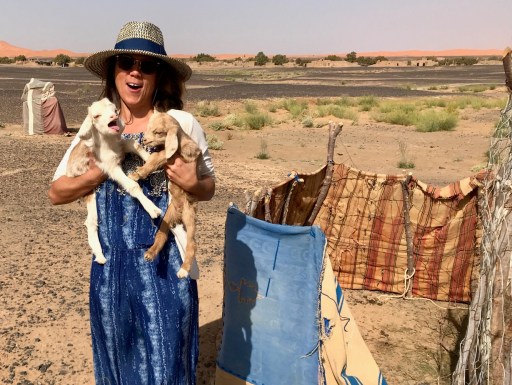Tagine is one of Morocco’s most notable dishes. It’s aromatic, zesty, and spicy. The cuisine offers a diverse range of ways it can be prepared from more meat-inspired stews to a bountiful display of vegetables. No matter what you order, this national dish is bound to put you in for a delightful surprise. But where can you find the best tagine Morocco has to offer? It goes without saying that you can find the best tagine in homes of Moroccans and not in a restaurant. So when I was invited for a cooking lesson at the home of a Berber family in Merzouga, I was excited to not only learn the ways of making
The mid-morning begins in the traditional mudbrick home of Mona and her family. It sits within a compound that her brother and businessman, Hsain, built in addition to the Merzouga Dunes Luxury Camps. I am welcomed in smiles by Mona and her two shy children who peak their heads around the corner to see if I’ll notice them.
While Mona prepares mint tea and snacks for me, the two girls finally gain enough confidence to shy away from the shadows and sit on the couch next to me. They give me a light hug and then we use our hands and facial expressions to communicate. I point to the older girl and raise my hand counting my fingers suggesting they show me how old they are.
I hold up five and the other girl mimics my hand with two fives and then a three. Then I learn the other one is nine.
I’m sitting in their version of a living room. The walls are furnished with long cushioned benches around the room with pillows. It’s always a little cold in the Moroccan homes I’ve been in, so I came prepared with socks and an extra jacket.

Mona takes a seat next to me with a small dish of almonds and peanuts and then sits down a tray with a tea kettle and Moroccan tea glasses. It’s always a little awkward thinking about what we’re going to talk about when there’s a language barrier, but she breaks the ice and pushes the tray of nuts toward me to eat. I grab a small handful of nuts while she pours the tea.
She gets up to bring out a blue plastic bowl of unpeeled vegetables soaked in water. I intently watch her peel carrots and potatoes in a rhythmic motion with a small peeling knife toward her chest. She then starts slicing the carrot, zucchini, potato, and onion in her hand instead of using a cutting board. I was especially impressed when she minced the onion into small pieces in a chopping motion while cupping the onion in her hand. She didn’t ask for my help and I knew my translation would be lost if I tried to ask, so I continued to study her instead.
We move into the kitchen with her two girls and I take a seat on a short one-foot stool next to a very short table. The clay tagine is placed on the table and she adds a little olive oil to the tagine along with a layer of minced garlic. There’s a clear plastic bag of seasoned chicken sitting off to the side that she pulls out and centers in the middle of the pot.
Tagine looks pretty simple so far. From what I’ve read it should be as easy as a slow cooker.
Mona smothers the chicken with onions and then begins layering the rest of the vegetables in chronological order: carrots, zucchini, potatoes, tomatoes, and sliced lemon. The children grab some spices from nearby and help sprinkle parsley, paprika, cumin, a green powdered spice, and ground saffron on top.

Mona’s brother, Hsain, returns and helps by pouring a small amount of hot water from the kettle in the clay pot. They cover the tagine, put it on the stove, and let it cook for 45 minutes.
I thought I’d have some lag time to sit and chat, but instead was asked to follow her outside to a small mudbrick structure. I peak my head in trying not to hit my head and see three other women besides Mona sitting lined up against the wall.
I’m watching from the outside for a couple of minutes until one of the girls moves and points to me and then points next to Mona where she was sitting. I understand the gesture and sit next to Mona, who’s in charge of the fire, getting a pretty good view of the clay oven they use to bake bread.

The three women all had bread pies about the size of a large pizza gathered under the blankets and then handing them to Mona one-by-one.
I meditatively gaze at the bread rising into a big bubble and then watch Mona twirl it in either a clockwise or counterclockwise motion and then pierce it with a stick when the bread expanded too much.
She grabs some flimsy twigs that are used to keep the fire going and then uses her two sticks to pull the bread out. She drops the bread on a nest of twigs that lay next to the oven and repeats.

The bubbly pie flattens on its own after it cools down and the woman to my left picks it up and begins to sweep off both sides removing any dirt or debris before placing the deflated bread in the basket hidden under the blanket in front of her.
After around five pies, Mona moves away from the fire and the girl to my left takes over. I notice she’s a little slower than Mona. She does look young and I imagine she’s still working on her skill set as Mona has probably done for many years already.
We leave the other women and walk back to her home only a minute away. The
The little girl then places a drawing of a blue river with an apple tree on the living room table in front of me but runs across the room still a bit shy and sits in a chair on the opposite corner. I notice the palm of her hands are covered in something orange or red and ask Mona.
“Henna.” Mona explains.
Progress! This is the first word Mona communicated that I understand.
Mona leaves back to the kitchen and the little girl comes with her backpack filled with markers and colored pencils. She pulls out a blank notepad and rips the first two pages off. She didn’t like how her paper was torn so she crumbles it up and tries again. Success. She’s now ready to draw and dumps her markers and pencils onto the table.
I pick up one of the wadded pieces of paper and open it up to draw on, but she pulls a fresh piece of paper for me to draw on instead.
I started drawing a dolphin hopping out of the water then moved onto drawing fish with stripes in a very elementary way. She continues to draw another river and apple tree on her piece of paper but this time with a sun on the upper right-hand corner.
Her dad gets home and sits beside her watching her draw.
I decide to add some land to my drawing and draw a brown line above the water and plant a few palm trees to the right. Then I decide to draw sand dunes in the background merging ocean and desert.
It’s missing something. A camel.
How do I draw a camel? The wifi isn’t working so I pull up a video of a camel I saw earlier in the day and put it on pause trying to replicate it the best way I knew how. The little girl curiously and intently watches me draw as I screw it up. It’s not making out to look like a camel so I adjust until it sort of resembles one. She’s miraculously inspired and asks her dad to draw one on her paper.
Lunch is ready.
We set the table and gather around the table. A small dish of assorted olives is placed on the table along with hand-pulled pieces of warm bread from earlier, and a small dish about the size of my hand filled with chopped green pepper, tomatoes, and onions.
The tagine is centered between us all and the lid is removed lending a zesty and aromatic fragrance to the table. I wait for them to go first so I can follow their lead. Each tears a piece of bread and dips it in the broth. This goes on for several minutes that I’m wondering at which point we eat the food, but I follow along.
Maybe they’re being polite and waiting for me to go first?
I don’t budge and finally see the dad grab a piece of bread, cupping it into his hand, and then using the bread as a utensil to grab some vegetables.
I follow suit and it’s my tagine epiphany moment.
“Whoa! This is so good. So damn good. This is what it’s about. I get it now.” I’m thinking.
The zest from the lemon added the perfect amount of acidity to the dish. The flavors of the spices, citrus, and vegetables had the perfect amount of time to marry allowing different flavor profiles to stand out on their own.
“This is so damn good.” I repeat in my head.
They see me struggling a little to pick up vegetables and come back with a fork and plate to help me. I’m determined to keep trying though, but I did occasionally resort back to my fork.
I am stuffed beyond oblivion but they keep adding more food to my plate as they share from the tagine. I point to my stomach and rub it in a circular motion moving my head from side to side saying no more.
They finally felt like I had enough to eat and then bring out a large bowl of fresh fruit, very traditional for Moroccan dessert.
The little girl grabs a banana and cuts it in half to eat and then grabs a whole one for me to enjoy. Oy, I don’t think I can handle a whole banana. The dad offers me a tangerine. I’ve become quite fond of the tangerines in Morocco; they’re always so sweet and juicy. The little girl looks at me disappointed I didn’t eat her banana and points at it, so I agree to appease her by eating half.
After lunch, I help clear the table with the little girl while Mona does the dishes. The little girl then helps me find a broom with my sweeping motions I used to ask her. We finish cleaning in time for my ride back to the camp and part our ways.
Having the opportunity to learn how to cook one of Morocco’s most notable dishes in an intimate family setting is always a special experience. I now understand why having a meal in a Moroccan family home is incomparable to restaurants. When you allow awkward communication barriers marinade with something familiar and relatable like family meals, it becomes one of a kind. Can you think of a time you experienced this was true? If so, I’d love to hear about it in the comments below.






